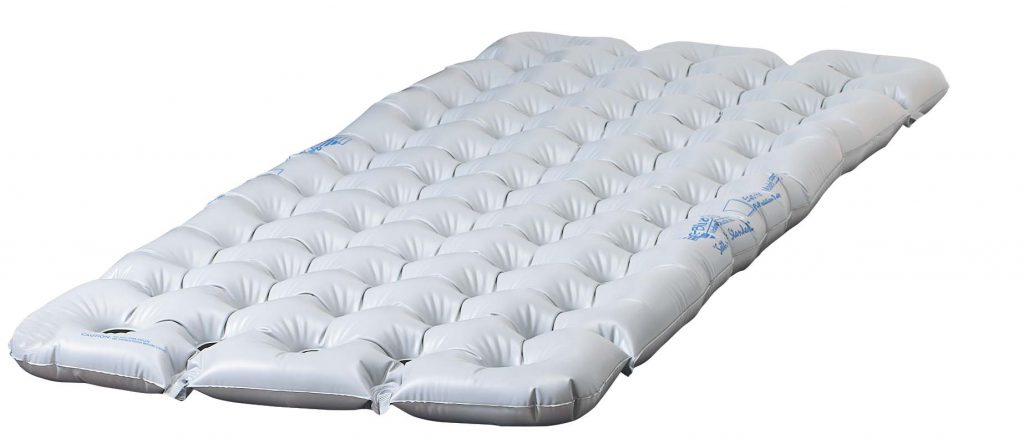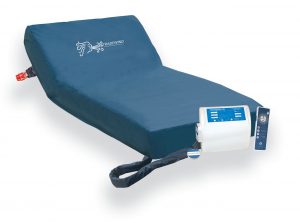Blue Chip Medical Products celebrates its 27th year of wound care innovation.
Blue Chip Medical Products proudly commemorates its 27th anniversary as a pioneer in the field of wound prevention and treatment. With a steadfast commitment to excellence and patient care, Blue Chip continually innovates new products that consistently set the standard for clinically effective wound care across the America’s and Europe. Through relentless research and development efforts, Blue Chip remains at the forefront of advancing wound prevention and treatment for Hospitals, Institutions, Nursing, Acute care, and Home Care.
Blue Chip’s latest advances in therapeutic mattress technology offer self-adjusting automation to provide patients optimal therapy while reducing patient handling. Other innovations change the way low air loss therapy is delivered, improving both the quality of the therapy as well as patient comfort and immersion. Yet other upcoming innovations will change the entire concept of pressure redistribution offering patients the most precise, individualized, and effective wound treatment. Blue Chip seeks to innovate the future of wound care.
As it celebrates this milestone, Blue Chip reaffirms its dedication to continue innovating and delivering cutting-edge solutions to address the evolving needs of healthcare professionals and patients alike.
Blue Chip is a proud US manufacturer and provider of therapeutic mattresses, wheelchair seating and positioning products, hospital products are much more. Blue Chip specializes in accommodating the needs of every patient: adult, pediatric, geriatric, or bariatric and the manufacture of custom mattresses and wheelchair cushions.
Blue Chip Medical Products, Inc.
7-11 Suffern Pl.
Suffern, NY 10901
Tel: (800) 795-6115
Web: www.bluechipmedical.com
The difference between Alternating Pressure and Air Fluidized Therapy AFT
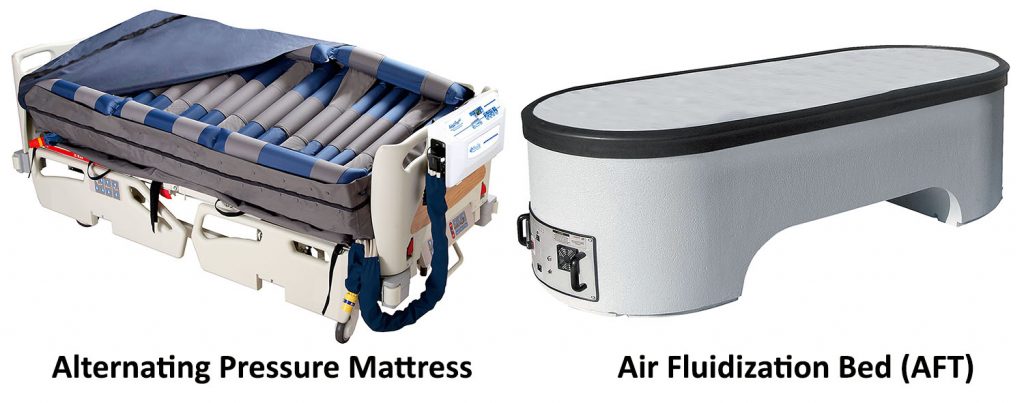
COMMON USE
ALTERNATING PRESSURE Prevention & Treatment of Stages I-IV Pressure Injury
AIR FLUIDIZED THERAPY Treatment of Stages III-IV Pressure Injury, burns, flap surgeries, grafts & unstageable wounds
Both AFT and Alternating Pressure therapy are for the treatment of late-stage pressure sores. There are benefits and restrictions to each therapy. However, where, when, and how each therapeutic mattress is utilized is often misunderstood. This article explores those factors to give the reader a greater understanding.
Similar to Alternating Pressure, Air Fluidized Therapy (AFT) is for the treatment of Stages III-IV pressure injuries. However, because AFT provides better pressure redistribution and immersion than alternating pressure, it is utilized for more advanced wounds including unstageable wounds, burns, post graft, and post flap wounds. While it seems logical to select AFT over alternating pressure for the treatment of stage III-IV pressure sores, Air-Fluidized Therapy has many downsides. These must be taken into consideration when selecting a support surface for the treatment of Stages III-IV pressure sores.
Blood flow is essential to keep the skin healthy and for wound healing. The goal of AFT and Alternating Pressure is to improve blood flow to the skin. Both therapies help to alleviate unrelieved pressure by pressure redistribution and the reduction of interface pressures between the body and the mattress. Additionally, both therapies create a healthy micro-climate via low air loss to help control the heat and moisture that can make the skin prone to breakdown. How each therapy achieves these goals is different.
ALTERNATING PRESSURE LOW AIR LOSS MATTRESS SYSTEM
An Alternating Pressure Mattress is constructed of a series of air bladders the width of the mattress whose internal pressures “alternate” in timed cycles. The internal air pressures are controlled by an alternating pressure pump and set according to patient weight and comfort. Many of the mattress bladders are ventilated to allow for the gentle flow of moisture and heat-reducing air.
How Alternating Pressure Mattress Systems Work
Basically, an alternating pressure mattress is comprised of two sets of air bladders in a series, an odd series (bladders 1,3,5,7,9, etc.) and an even series (2,4,6,8, 10, etc.). While the odd series bladders are inflated and firm, the even series bladders deflate and soften. In 10-minute cycles the soft bladders become firm and the firm bladders become soft. This continually provides pressure redistribution between the body and the mattress, to help prevent and treat pressure injuries and diabetic wounds. Where and how the body is supported changes. Additionally, Alternating Pressure helps improve blood flow through a process called Reactive Hyperemia. Low Air Loss therapy is achieved through lasered holes in the bladders that allow air to gently escape.
In more advanced mattress systems such as Blue Chip Medical’s Adapt Pro Elite, the low air loss function is built into the cover thereby enhancing the low air loss therapy. Furthermore, these quality systems offer immersion therapy via a pulsation mode.
PRO
– Prevention and treatment of stages I-IV pressure wounds
– Excellent pressure redistribution
– Enhanced Low Air Loss Therapy
– Immersion therapy via pulsation mode
– Available in a greater range of mattress sizes to fit standard hospital bed frames
– Models to support bariatric weights up to and including up to 1000 lbs.
– Suitable for a more diverse patient population for size and weight.
– Surface stability and balance
– Adjustable patient comfort
– Automated features provide optimal therapy & require less caregiver training
– Low Maintenance
– Ease of transfers & patient care
– Offers full body therapy in Fowler position
– Low cost of acquisition and operation
– Possible use for post flap & post graft wounds
DISADVANTAGE
– Not suited for burns
AIR FLUIDIZED THERAPY (AFT)
An air-fluidized bed is commonly referred to as a sand or bead bed. There are full-body AFT and partial-body AFT therapy bed frames. On a full-body AFT bed, the patient must lay flat and rely on a wedge to achieve an incline position at the head of the bed (Fowler). A partial body frame provides the ability to incline the head of the bed however, limits the therapeutic area.
How do Air Fluidized Beds Work?
An Air Fluidized Bed is filled with approximately 1200 lbs. or more silicone beads. A powerful air pump blows air through the beads. The silicone beads rotate and frack essentially giving the beads the properties of a fluid, hence the term “Air Fluidization”. Air Fluidization therapy allows for immersion and envelopment of the patient into the surface and the equalization and reduction of interface pressures across the weight-bearing surfaces of the body. The powerful airflow rises through the cover to help keep the patient’s skin cool and dry.
PRO
– Advanced pressure redistribution for treatment of late-stage pressure injuries
– Appropriate for unstageable wounds
– Appropriate for burns
– Use for post flap & post graft wounds
– True Low Air Loss Therapy
– Excellent immersion therapy
DISADVANTAGE
– Patient dehydration due to high heat and airflow
– Difficulty with patient transfer and care
– May require a patient lifter for transfer
– Surface instability makes patient positioning difficult
– Weight of the bed and beds can exceed 1500 lbs or more
– Disinfection and cleaning of the beads
– Not easily suited for home use
– Can increase the ambient room temperature up to 10-15 degrees or more
– Cleanliness
– Maintenance
– Caregiver Safety
– Significantly High Cost generally for rental
Patient dehydration
In an already difficult recovery process, dehydration due to the high heat of air fluidization can affect healing and be very problematic for the patient.
Patient transfer & care
Since the patient can immerse in the surface, it can be difficult for a caregiver to reposition the patient for care or transfer. In many cases, the use of a patient lifter is required.
Surface instability & patient positioning
Due to the instability of the silicon bead medium, the surface can interfere with patient repositioning, Fowler positioning, and side-lying.
Weight of the bed for home use
The AFT bed is filled with approximately 1200 lbs or more of silicone beads. The full weight of the bed without a patient is approximately 1,500 lbs. This is often too much weight for home use. AFT should only be used on a supported first floor.
Cleaning and disinfecting of the beads
There are approximately 1200 lbs. of silicone beads that require cleaning and disinfection. If a patient is incontinent, body fluids, urine, and feces can infiltrate the cover. This requires the beads to be disinfected, normally monthly or sooner depending on the patient. Disinfecting the beads requires the beads to “cook” for 12 hours and then cool. Some AFT systems can clean and disinfect while others require a second piece of disinfection equipment called a bead cooker. In either case, the patient must be transferred from the bed and placed on an alternate therapeutic surface for the entire duration of the disinfection process (12 hours to cook and 12 hours to cool).
Disinfection through the use of special equipment requires up to 1,200 lbs of the beads to be removed from the bed. The clumped silicone “cookies” must be sifted and removed. The balance of the sifted beads is then placed into the disinfection equipment and “cooked” for approximately 12 hours. The beads are then cooled for as long as 12 hours before they can be replaced. To reduce patient handling and discomfort, another option is to have a second set of clean beads ready to be placed into the bed, while the soiled beads are being cleaned and disinfected. Cleaning is time-consuming, interferes with patient therapy, and is costly in energy use.
Ambient Temperature
While the temperature of the air flowing through the beads can to some degree be adjusted, the powerful air pump generates a lot of heat. This excess heat can increase the ambient room temperature up to 10 – 15 degrees or more in an already warm environment. This may require air conditioning to counteract the high room temperature to keep the patient comfortable.
Cleanliness, Caregiver Safety & Maintenance
The silicone beads often become airborne. They dirty all surfaces including the floor. Since the beads are slippery, this increases the possibility that a caregiver or patient may slip and fall. Cleaning and maintenance must be conducted on a regular basis.
Cost
AFT beds often range from $35,000 – $65,000 plus the cost of the beads and disinfection equipment. This is greater than 10 times the cost of a high-quality Alternating Pressure Mattress System ranging from $2,800 – $4,500. There are recurring maintenance costs for AFT. Even the monthly rental costs for AFT are very expensive.
Why it Matters?
Before selecting Air Fluidized Therapy for home use one must weigh the benefits and drawbacks: negative effects of possible patient dehydration and position in an already compromised patient, the amount of maintenance, cleanliness, and quality of care required for effective Air Fluidized Therapy, weight limitation of existing structure, environmental factors, cost and more.
Conclusion
Air Fluidized Therapy offers more advanced pressure redistribution, immersion, and air loss therapy, for the treatment of Stages III-IV pressure sores. However, alternatives such as a high-quality, hospital-grade Alternating Pressure Low Air Loss Mattress system should be considered, even for postflap or postgraft patients.
What is Reactive Hyperemia and Why it’s Important for Wound Care
Reactive hyperemia is the body’s response to periods of inadequate blood supply to a tissue or organ such as the skin. This phenomenon in wound care, refers to increase of blood circulation in the small arteries and capillaries after the skin has experienced a temporary obstruction in blood flow. Obstruction in blood supply to the skin occurs from prolonged unrelieved pressure between the body and the support surface (ie wheelchair or recliner seat, mattress or more). This often results in pressure related injuries especially for those less mobile who are unable to reposition.
When blood flow to the skin is reduced or completely obstructed, certain metabolic changes occur within the skin. These changes include the accumulation of metabolic byproducts like carbon dioxide, lactate, and adenosine, as well as the depletion of oxygen and nutrients. Prolonged depletion of oxygen and nutrients in the skin cells causes the skin cells to malfunction and eventually die.
Reactive hyperemia occurs when the obstruction to blood flow is removed or reduced. This allows vital oxygen and nutrients to reach the affected skin.
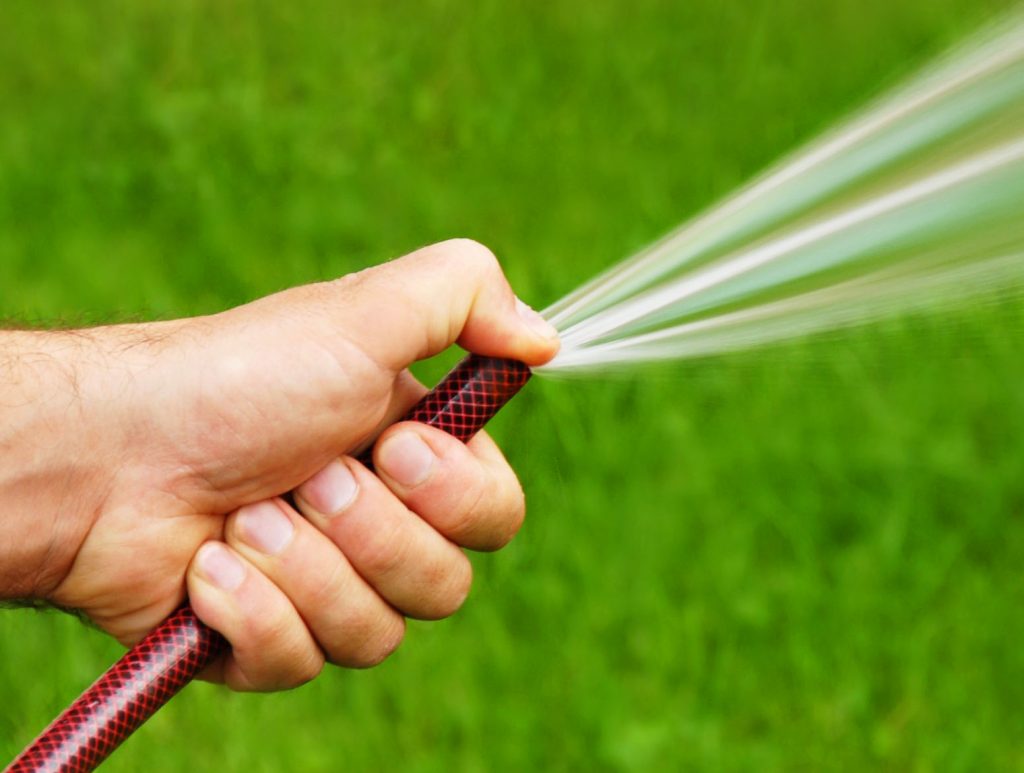
An example in its simplest form,
Picture a garden hose. Pinch-off a garden hose with a thumb creating an obstruction in flow. Maintain the obstruction for 30 seconds and then release the pressure. The result is an initial pulse of water. Applied to the skin, the sudden restoration of blood flow surpasses normal levels in the affected area. In wound care, Alternating Pressure therapy with its timed cycles of “alternating pressure” is based on Reactive Hyperemia. Slight pressure applied to the skin, once released, forces increased flow of blood into the skin. This increase in blood flow compensates for the oxygen and nutrient debt incurred during the period of reduced blood supply.
In addition to the physical forces that increase blood flow, there is a complex interplay of metabolic factors and cell signaling that work to allow the rapid and increased restoration of blood supply.
The accumulation of metabolic byproducts during the lack of blood flow triggers the body to respond. One such byproduct, adenosine, stimulates the release of vasodilator substances such as nitric oxide (NO). Nitric Oxide causes the relaxation of the smooth muscle cells in the blood vessel wall (Endothelial cells). When the blood vessel wall relaxes it opens/dilates allowing more blood to flow to the affected skin. The increased blood flow delivers vital oxygen, nutrients required for skin health, and is essential for healing of pressure wounds.
Reactive hyperemia serves as an essential physiological mechanism to restore proper blood flow and is crucial for prevention and treatment of pressure wounds.
IMPORTANT NOTE:
The above are general statements, there are some exceptions. The above is not meant to diagnose or treat any medical condition.
Always seek the advice of a wound care professional.
The Difference Between a Lateral Rotation Mattress and an Alternating Pressure Mattress
What are the differences between therapies for the prevention and treatment of Pressure Sore Injuries?
Within wound care there are misconceptions between the therapies and when each is appropriate. One of the most common misconceptions is that Lateral Rotation is more advanced than alternating pressure at wound treatment. This is especially true when a patient is not responding to alternating pressure. To help understand the differences between mattress systems, below is an explanation of each and factors to consider when choosing a wound healing mattress for a patient.
Lateral Rotation Mattress vs Alternating Pressure Mattress
Both mattresses redistribute pressure for the prevention and treatment of Stages I – IV pressure sore injuries. Lateral Rotation therapy rotates the patient to achieve pressure redistribution while in Alternating Pressure, the mattress bladders alternate underneath the patient.
LATERAL ROTATION
A lateral rotation mattress provides pressure redistribution by turning the patient side to side up to 40 degrees. This movement helps redistribute pressure to help prevent and treat stages I-IV pressure ulcers. However, a Lateral Rotation mattress is utilized when specific conditions exist. One of the most important considerations is the presence of significant respiratory issues such as Pneumonia. If the conditions outlined below do not exist, an Alternating Pressure Mattress with Low Air Loss may be more appropriate. Additionally, if a patient has skin breakdown on the hips, one must be careful to take that into consideration.
What to consider when considering the use of a lateral rotation mattress system?
Deciding if a Lateral Rotation Mattress system is a more appropriate choice than an Alternating Pressure Mattress? Please consider the following factors:
1. Does the Patient predominately lay flat?
2. Does the Patient have or is highly prone to developing significant respiratory issues such as Pneumonia?
3. The patient requires skin protection but does not have late stage skin breakdown on the hips
4. The patient does not transfer independently
If the answer is YES to questions 1- 4, a Lateral Rotation Mattress System may an excellent therapy to prevent and treat pressure injuries. If the answer is NO, keep reading.
Lateral Rotation Mattresses are meant to be utilized in the predominately flat position.
If the head of the patient’s bed is raised, the use of a lateral rotation mattress may increase fall risk. One may be able to incline these mattress systems slightly however, the fall risk increases with each degree of incline. This is especially true when someone does not possess the core strength needed to keep themselves seated up-right. It is recommended to use rails to prevent any accidental falls. Lateral rotation mattress systems are designed to be used in the predominantly flat position! This precludes patients who raise the head of the bed or who must have their heads elevated.
Lateral Rotation Mattresses helps to move fluid in the lungs.
A Lateral rotation mattress rotates side to side in a timed sequence to help prevent pressure injuries. However, that same side to side movement helps move fluid in the lungs to reduce respiratory issues. If someone has both significant respiratory and skin breakdown concerns, a lateral rotation low air loss mattress system may be a more appropriate choice.
Lateral Rotation can put additional pressure on the hips.
If a patient presents with late stage or unstageable pressure sore injuries on the hips, turning the patient to the side with the injury can put additional pressure on the injury. To help alleviate this, the mattress can be set to only turn in the opposite direction of the injury, limiting therapy. The location of pressure injuries should be a consideration.
Note: Many lateral rotation mattress systems only rotate the patient up to 25 degrees. Choose a lateral rotation mattress system that can rotate from 30 up to 40 degrees. Blue Chip Medical’s Power Pro Elite™ is an excellent example of a true lateral rotation mattress system.
ALTERNATING PRESSURE MATTRESS SYSTEM
An Alternating Pressure Mattress is constructed of a series of horizontal air bladders that cover the full width of the mattress whose internal pressures “alternate” in timed sequenced cycles. The internal air pressures of the bladders are controlled by an alternating pressure pump and set according to patient weight and comfort.
For simplicity, a Blue Chip Medical alternating pressure mattress has 18 air bladders. There are two sets of air bladders in a series. There is an odd series (bladders 1,3,5,7,9, etc) and an even series (2,4,6,8, 10, etc). While the odd series bladders are inflated and firm, the even series bladders are deflated and soft. In timed sequenced cycles the soft bladders inflate to become firm as the firm bladders become soft. Within that exchange from soft to firm, all bladders hold at the same pressure for one minute. This continually redistributes the pressure between the body and the mattress, to help prevent and treat pressure sores and diabetic wounds. Additionally, Alternating Pressure improves blood flow through a process called Reactive Hyperemia.
Alternating Pressure can be utilized in the flat or inclined position.
Alternating Pressure therapy can be utilized for a patient in the prone or Fowler positions up to 65º. Some advanced mattress systems such as Blue Chip’s Adapt Pro Elite™ provide an automatic Fowler adjustment to prevent sinking into the mattress and skin shearing injuries.
Alternating Pressure with Low Air Loss should be considered for the prevention and treatment of stages I-IV pressure sore injuries when the following exists.
1. The patient is receiving therapy when the head of the bed is inclined.
2. The patient is tube fed
3. The patient does NOT have or is prone to significant respiratory issues such as Pneumonia.
4. The patient requires prevention and treatment of stages I-IV pressure injuries.
5. The patient transfers independently (mattress should be placed in the static mode while transferring)
6. COPD and can be raised a minimum of 30 degrees or more
It is important to assess the patient and take all the factors above into consideration when selecting the appropriate therapeutic mattress for wound care and prevention. Both Lateral Rotation with Low Air Loss and Alternating Pressure with Low Air Loss mattress systems are excellent therapies at preventing and treating pressure injuries, when matched properly to the patient’s needs.
IMPORTANT NOTE:
The above are general statements, there are some exceptions. The above is not meant to diagnose or treat any medical condition.
Always seek the advice of a wound care professional.
Blue Chip introduces Automated mattress functions that directly address a leading cause of skin breakdown.
Sinking into an Alternating Pressure Mattress is a common and overlooked problem that can lead to the development of wounds that must be addressed at the root cause.
For those with limited mobility, repositioning is essential to help prevent skin breakdown. A hospital bed frame that allows the patient to change the position of their head and feet can assist. However, raising and lowering the head of the bed into a Fowler Position can also increase a person’s risk of skin breakdown.
Bed Position
If a bed is in the supine position, a person’s weight is distributed across the entire surface of the body. However, when the head of the bed is inclined into a Fowler position, body weight shifts from being supported over the entire body surface to concentrated weight straight down on the patient’s bottom. This causes the patient to SINK into their mattress.
Sinking into a mattress is a leading cause of skin breakdown.
Sinking into a mattress causes the patient to ingress deeper into the mattress. As the patient sinks, they slide, and as they slide they are at a much higher risk of skin shear. This skin shear is often seen in the coccyx or sacral area. As bed position is changed by the caregiver and patient throughout the day, the shearing forces are continual. This creates an environment for non-healing wounds and if not corrected, promotes recurrence.
Blue Chip’s Automated Fowler Function helps Hospitals and nursing staff prevent skin shear in their patients.
Blue Chip Medical’s Adapt Pro Elite™ with enhanced low air loss features an Automatic 2-Stage Fowler Function. Blue Chip’s unique therapeutic function measures the degree of incline at the head of the bed and automatically adjusts pressures in the Sacral bladders to prevent patients from sinking, sliding, and shearing.
Adapt Pro™ Elite – Alternating Pressure, Enhanced Low Air Loss Mattress System with Automatic 2-Stage Fowler Function offers advanced and automated wound care technologies that improve patient care for the treatment and prevention of stages I-IV pressure and shearing injuries.
Hospitals and long-term care facilities report improvement in skin health, positive outcomes and patient comfort as the automated features reduce the workload on nursing staff.
The unique automated features of Blue Chip’s Adapt Pro Elite™ mattress system help prevent a leading cause of skin breakdown and treat coccyx and sacral wounds.
For more information on Blue Chip’s Adapt Pro Elite or other advanced wound care systems call (800) 795-6115 or visit us on the web at www.bluechipmedical.com
LINK: https://www.bluechipmedical.com/mattress-systems/air-mattress/adapt-pro-elite/
Improving Mental Health Care using a Blue Chip Static Air Overlay Mattress
Improving Mental Health Care using a Blue Chip Static Air Overlay Mattress
By: Karen Valencia Hamed MSN, AMB-RN, CWOCN, Nurse Care Manager
A Mental Health Acute Care inflatable static air overlay mattress
Patients in an Acute Mental Health unit have limited options among medical assistive devices. In this environment, limitations are in place to mitigate the risk of self-harm, as well as protection to other patients and staff from agitated behaviors. Because of these protective factors, standard inflatable overlay mattress cannot be used on an acute Mental Health unit due to small removable parts and corner straps that hold the mattress in place. Because of these risk concerns, a need for a functional, low-risk mattress, safe for the acute Mental Health inpatient setting was identified.
In our Medical Center, we have a 36-bed acute Mental Health unit. A standard inpatient room consists of stationary bedframes with a standard twin-size pressure-relieving foam mattress. The patient population ranges from young adults to the elderly. There have been some complaints of the mattress being uncomfortable by those patients who were sleep-deprived, those with chronic pain such as arthritis, and patients with skin injuries from pressure injuries and traumatic wounds.
All people need to sleep. Sleep is imperative for life, it is a biological requirement (Smyth, 2020). Rest and sleep are a critical element in healing from an acute mental health episode. Sleep hygiene is extremely important for those patients with a history of mental illness, because long episode without sleep is associated with cognitive difficulties, that can range from changes in a person’s mood to psychotic episodes such as hallucinations (Plante, D March 2020). Bernecker, et al (2020) states that sleep insufficiency has a direct influence on a person’s cognitive functioning.
After spending time searching for an inflatable static air overlay mattress, all options available were unacceptable for the acute inpatient Mental Health population. All the mattresses were manufactured with small removable parts and straps. The search began to find a company that would develop an inflatable static air immiscible overlay mattress that was safe for the acute Mental Health population. The following parameters were used as guidelines: the mattress must be single patient use, have no strings or small removable parts that could cause someone harm, have an adhesive bottom to stay on the bed, and it must be cost-efficient. After contacting several companies, Blue Chip Medical Products, Inc. in New York agreed to develop a prototype that met the guidelines listed previously and to include the following design: fits a single bed, no straps, non-skid adhesive strips on the bottom of the mattress, weight limit of 300 lbs., hand inflated, latex-free, cleans easily, and provides comfort and pressure redistribution.
Blue Chip Medical products produced a prototype for approval. The mattress was inspected and approved by the Mental Health Service Line Chief, Chief Nurse of Mental Health, Clinical Nurse Leader, and the Nurse Manager. The Chief of Mental Health provided a risk assessment document. To gain approval for a facility for trial, a request was submitted to the facility’s Clinical Products Review Committee (CPRC). The CPRC approved the Blue-Chip inflatable mattress for a ten-patient trial over three months.
Criteria was developed on who would receive the Blue-Chip Overlay Mattress. Upon admission, if a Veteran presented with two or more of the following issues they were offered a Blue Chip Overlay Mattress: chronic pain, bipolar disorder, psychosis, sleep deprivation, a stage 1 or 2 uncomplicated pressure injury, or had broken skin due to trauma or burns.
The trial dates were set for December 1, 2020 to March 1, 2021. Acute Mental Health nursing staff was educated on the product and the criteria for those who can receive a mattress for the trial. After three months, seven participants had successfully completed the trial, a lower number than anticipated due COVID-19 virus concerns.
To evaluate the overlay mattress for comfort and pressure relief, a Likert scale evaluation tool was developed. Each patient was asked to evaluate their satisfaction with the Blue-Chip Overlay Mattress. All patient responses were positive. Not all the participants provided additional comments, but the nursing staff noted that after putting the Blue-Chip Overlay Mattress on the bed, Patient X rested well through the night and was less restless and agitated in the morning. One patient was transferred into acute Mental Health from a medical-surgical unit with a healing stage 2 pressure injury. The patient said that he was able to rest better with the overlay mattress and the wound did not increase in size during his stay.
The nurses were also asked to evaluate mattress placement and care. There were no negative comments in their evaluations.
When delivering the outcomes of the trial to the CPRC members, it was a unanimous vote to approve this product as a safe option in care for our Mental Health Service Line. Currently, this product can be used in our acute Mental Health unit, Substance Abuse unit, and Post-Traumatic Stress unit.
To provide consistency in the mattress air volume and pressure, the staff will check the overlay mattress each shift. The mattress is checked by placing a hand between the air mattress and the foam mattress, at the hip area, to make sure there is enough volume of air pressure to float the patient’s body off the foam mattress. This ensures an allowance for immersion into the mattress to distribute their weight throughout the surface area, reducing pressure over bony prominences.
The following changes were made to the nursing documentation template:
Is patient on Blue Chip Overlay Mattress _____ Yes _______No
Air pressure checked in Blue Chip Overlay Mattress __________Yes ____________No
For Mental Health care, this product provides a fantastic opportunity to deliver quality care on mental health units that promotes comfort, aids in healing, and prevents pressure injuries.
If you would like this product for your facility, please contact:
Blue Chip Medical Products, Inc.
7-11 Suffern Place
Suffern, NY 10901
1-800-795-6115
www.bluechipmedical.com
References
Bernecker, Katharina, job, Veronika. Too exhausted to go to bed: Implicit theories about willpower and stress predict bedtime procrastination. British Journal of Psychology, Vol 111 (1), Feb, 2020 pp.126-147. Publisher: Wiley-Blackwell Publishing Ltd.; [Journal Article], Database: APA
Plante, David. The Importance of Sleep Phenotypes in Bipolar Disorders. JAMA Psychiatry. March 2020, 77,3, p.235-236
Smyth, Aisling; Australian Nursing & Midwifery Journal, Oct-Dec 2020;27 (1); 42-42. ½ p.
Disclaimer:
The views of this article do not necessarily represent those of the Salem Veteran Affairs Hospital or the Government, but those of the individual author.
Mattress made for those with spinal cord injury allows independence and comfort control
Alternating Pressure Mattress Made Specially for People with TSCI / Spinal Cord Injury.
Traumatic spinal cord injury (TSCI) is a substantial cause of impairment, with serious physical, functional and emotional repercussions. While TSCI will not exclusively compromise the life of the person after the occurrence, the reduction in functional independence has the greatest impact on a lot of people. The TSCI patient requires additional attention and care. Often it’s the immediate family that willingly accepts the role of a healthcare provider. However, many TSCI patients desire to be self-reliant to control their own comfort or even to participate in their care process which includes preventing pressure ulcers.
For most TSCI patients, Skin protection is achieved by using an alternating pressure mattress with low air loss. While though very efficient at skin protection, these systems need a care giver to regulate the standard or basic functions of system including patient comfort. For independent people with spinal cord injuries, this implies that they must count on others to control their comfort.
You can find recent advancements and innovations in skin protection support that addresses this need for those independent people who have spinal cord injuries. Based on request of an agency that provides medical services to those injured in action, Blue Chip Medical Products developed an alternating pressure with low air loss mattress system that features a hand held remote. The Tradewind-ATS-RC with remote control is simply perfect for any independent person who has been debilitated by a traumatic spinal cord injury or condition that affects their mobility. The Tradewind-ATS-RC Alternating Pressure Mattress with Low Air Loss provides a maximum in skin protection while providing people who have TSCI, traumatic spinal cord injuries to regain control of their comfort and independence 24/7 without the need of a care giver.
The Tradewind ATS-RC with wired patient remote is an easy to operate, easy to read hand held remote. The remote provides control over mattress pump functions including:
• Power
• Comfort Settings
• Alternating & Static Modes
• Cycle Time
• Auto Firm
• System Alerts
These remote functions allows independence and control of the therapeutic sleep surface 24 hours and day 7 days a week.
Available in 35”, 42” & 48” and models to support up to 750 lbs. For more information regarding the Tradewind ATS-RC.
Blue Chip Medical Products Inc. is a manufacturer of a full line of therapeutic mattresses, seating and positioning products and more. Blue Chip Medical’s manufacturing facility is located in upstate New York. Their products utilize the highest quality medical materials sourced in the USA.


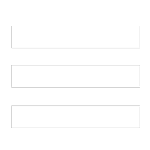 MENU
MENU
